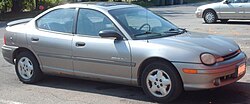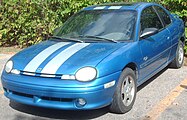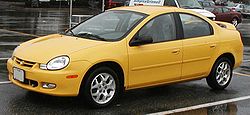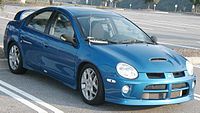Dodge Neon
| Dodge Neon | |
|---|---|
| Production period: | 1994–2005, since 2016 |
| Class : | Compact class |
| Body versions : | Limousine , coupe |
| Previous model: | Dodge Shadow , Plymouth Sundance |
| Successor: | 2nd generation: Dodge Caliber |
The Dodge Neon was a lower mid-range model built by the US automobile manufacturer Chrysler from the beginning of 1994 to late summer 2005 .
The first model series was built from January 1994 to August 1999, the second from August 1999 to September 2005. It was replaced in early 2006 by the Dodge Caliber .
The Plymouth Neon was the completely identical sister model; in the export the Neon was called Chrysler Neon (for more details see there). The neon of the US market is discussed below.
Since 2016, the notchback version of the Fiat Tipo has been sold as the Dodge Neon in some markets.
Neon (1994-1999)
| 1st generation | |
|---|---|
|
Dodge Neon Sedan (1994–1999) |
|
| Production period: | 1994-1999 |
| Body versions : | Limousine , coupe |
| Engines: |
Petrol engines : 1.8–2.0 liters (85–110 kW) |
| Length: | 4364 mm |
| Width: | 1707 mm |
| Height: | 1341-1392 mm |
| Wheelbase : | 2640 mm |
| Empty weight : | 1051-1136 kg |
At the beginning of 1994 the Dodge / Plymouth Neon made its debut as the successor to the Dodge Shadow and the Plymouth Sundance as the 1995 model. The hallmark was the so-called cab-forward design with a long wheelbase, a forward passenger compartment and a short bonnet.
Only the sedan was available for market launch; the coupé followed in autumn 1994. The basic model (only as a four-door model), the Neon Highline and the Neon Sport were available. All variants had a two-liter four-cylinder (98 kW / 133 PS) with an overhead camshaft as standard, only in the Neon Sport Coupe was the DOHC version (110 kW / 150 PS) of the machine installed, which is otherwise subject to a surcharge. Power was transmitted via a five-speed manual gearbox or an optional three-speed automatic transmission.
In the 1996 model year, the coupé was also available in the basic version and for the Neon Highline an expresso package was added to the range, which included special decorative stripes and a bonnet with a promising hood. The SOHC two-liter was now standard in all models, including the sports coupé. In 1997 the Sport equipment line was discontinued and was replaced by a Sport package that was available for Highline models at an extra charge.
In the model years 1998 and 1999, the neon program expanded into the versions Neon Highline, Neon Sport and Neon R / T, the latter in special colors and with a decidedly sporty equipment. At Plymouth the equipment levels were called Highline, Expresso and Style, whereby the Style was only available as a four-door and was not a counterpart to the R / T, but a comfort-oriented variant. The relatively loud two-liter was revised at the same time with regard to lower running noise and vibrations.
From 1996 to 1999 there was also a Neon ACR as a basic model for racing.
A total of 910,000 neon units of the first generation were produced (excluding 1999).
Neon (1999-2005)
| 2nd generation | |
|---|---|
|
Dodge Neon (1999-2002) |
|
| Production period: | 1999-2005 |
| Body versions : | limousine |
| Engines: |
Petrol engines : 1.6–2.4 liters (85–171 kW) |
| Length: | 4430 mm |
| Width: | 1711 mm |
| Height: | 1421 mm |
| Wheelbase : | 2670 mm |
| Empty weight : | 1164-1300 kg |
In the second generation, the Dodge Neon was only produced as a four-door sedan. From then on, four-cylinder engines with 1.6 and 2.0 liters displacement, as well as the top version 2.4 L Turbo, were available. The latter was officially sold under the name Dodge Neon SRT-4. The Dodge Neon was offered in Germany under the brand name Chrysler Neon.
In the late summer of 2005, production of the Neon was discontinued, and the Dodge Caliber was launched as a successor in spring 2006 .
In August 1999, the second generation Neon was presented with a slightly longer wheelbase than the Dodge or Plymouth Neon. The interior turned out to be a bit more spacious, and the engines again gained a bit of smoothness.
At the beginning, the new Neon was only available with the 98 kW (133 PS) two-liter engine, which was supplemented by a 112 kW (152 PS) variant with a variable intake system for model year 2001 (as a replacement for the DOHC that is no longer used -Engine). At the same time, the three-speed automatic was replaced by a four-speed and the second generation Neon R / T was launched.
Facelift
For the 2003 model year, the Neon, which has only been available as a Dodge since the Plymouth brand was discontinued in 2001, received a facelift in autumn 2002 with a Dodge-style radiator grille with intersecting struts.
As an independent model, albeit based on the neon, the high-performance variant Dodge SRT-4 was marketed from 2003 to 2005 . It was a very powerful neon derivative with initially 160 kW (218 hp), from model year 2004 with 171 kW (233 hp), with a weight of 1300 kilograms.
The last neon rolled off the line at the end of September 2005.
Neon (since 2016)
| 3rd generation | |
|---|---|
|
Dodge Neon (since 2016) |
|
| Production period: | since 2016 |
| Body versions : | limousine |
| Engines: |
Petrol engine : 1.6 liters (81 kW) |
| Length: | 4532 mm |
| Width: | 1792 mm |
| Height: | 1497 mm |
| Wheelbase : | 2638 mm |
| Empty weight : | 1280 kg |
The third generation corresponds to the notchback version of the Fiat Tipo built in Bursa , Turkey . It is sold in some markets such as the Middle East and Mexico . The vehicle is also to be sold under this name in North America.
Technical specifications
| Parameters | 1.6 |
|---|---|
| Construction period | since 2016 |
| Engine characteristics | |
| Engine type | R4 petrol engine |
| Displacement | 1598 cc |
| Max. power | 81 kW (110 PS) at 5500 rpm |
|
Max. Torque |
152 Nm at 4500 rpm |
| Power transmission | |
| Drive, as standard | Front wheel drive |
| Gearbox, as standard | 6-speed automatic transmission |
| Readings | |
| Top speed | 192 km / h |
|
Acceleration, 0-100 km / h |
11.2 s |
|
Fuel consumption over 100 km (combined) |
6.3 l super |
swell
Flammang, James M./Kowalke, Ron: Standard Catalog of American Cars 1976-1999. Krause Publications, Iola 1999. ISBN 0-87341-755-0






